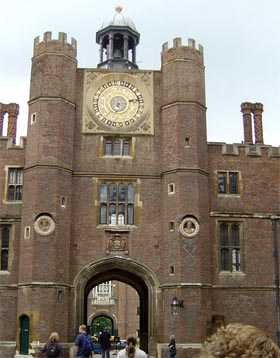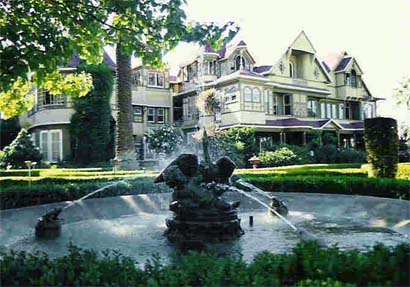|

A
"spirit" photo supposedly showing a ghost.
|
The
Science of Ghosts and Hauntings
They are called phantasms, specters
or spirits. The ancient Greeks referred to them as shades
while in Scotland they are known as wraiths. The Germans
use the word spook, unless they cause a racket in which
case they get the label poltergeist. Most people just call
them ghosts and are either fascinated by them, or are terrified
of them, or sometimes both.
The belief that human spirits could continue to
haunt the living after death goes back to ancient times. We know
that many primitive societies' burial customs included rituals
to banish the spirits of the departed from the earth. As far back
as biblical times, King Saul had the Witch of Endor summon the
spirit of dead prophet Samuel for advice. More recently, in the
late 19th and early 20th century, the belief that the living could
contact the dead through spiritualism and séances tickled the
public's fancy. Currently TV shows where "ghost hunters" trek
to supposedly haunted locations to find spooks are popular on
the cable channels.
What does science have to say about ghosts and their
hauntings? Are they real? Or are they just the product of our
overactive imaginations?
Souls
Not at Rest
Most ghost stories are connected with the idea that
spirits are the souls of people who died under difficult circumstances
- for example, murder or suicide - and continue to inhabit the
earth. Troubled by their death, they haunt the places where they
lived and died, unable to move on to the afterlife. One early
account of this involves the Greek philosopher Athenodoros Cananites.
Athenodoros became interested in a haunted house in Athens and
started watching it at night. Late one evening an old man, bound
at the feet and hands with rattling chains, appeared to him and
beckoned the scholar to follow him. The ghost disappeared suddenly
and Athenodoros had the spot where he vanished dug up. A man's
shackled bones were found at the location and after a proper re-burial,
the haunting ended.
Tales like those of Athenodoros are typical but
don't really prove that ghosts exist. For science to confirm anything
a phenomenon must be repeatable. Unfortunately ghosts, if they
exist, do not seem to keep a regular schedule and their sporadic
appearances make scientific observation nearly impossible. In
addition, there is no scientific theory involving physics to explain
how ghosts would work.
The
Problems of Proving Ghosts
This, however, does not prove that ghosts do
not exist. For many years scientists refused to believe in
meteorites because their falling out of the sky was sporadic and
not predictable or repeatable. Scientists also viewed the universe
as perfect and had no theory to explain how there could be little
pieces of extra rock floating around in space.
Of course, meteorites do exist and they now have
been observed on many occasions. They also fit in with our current
scientific theories. Might we one day be able to prove ghosts
exist? Even if we can't do that today, perhaps science can do
the next best thing and prove that a location is "haunted."
|

Part
of the "haunted" Edinburgh Vaults. (Licensed
from Kjetil Bjørnsrud/Wikipedia Commons)
|
This is exactly the type of research that Professor
Richard Wiseman of the University of Hertfordshire in the United
Kingdom has done. Wiseman is known for his investigations on the
quirky side of science, delving into such areas as humor, luck
and the paranormal.
The
Haunted Edinburgh Vaults
In 2001 Wiseman decided to investigate the underground
"haunted" vaults under Edinburgh, Scotland's, South Bridge. The
bridge was constructed in the late eighteenth century and consists
of nineteen large stone arches supporting a road lined with several
three-story buildings. A number of rooms and corridors were built
under the arches to house workshops, storage areas and accommodations
for the poor. This place soon became a disease-ridden slum that
was abandoned by the late nineteenth century. The area was rediscovered
and opened for public tours in 1997 and soon tourists and guides
were experiencing many unusual phenomena, including a strong sense
of presence, the appearance of several apparitions and the sounds
of 'ghostly' footsteps. Soon the Vaults acquired a reputation
for being one of the most haunted spots in Edinburgh.
Since some of the rooms in the Vaults had the reputation
of being haunted, while others did not, Wiseman designed his experiment
to see if people who were not familiar with the reputations of
each of the rooms would sense anything unusual with them.
Over the course of four days volunteers entered
the vaults and recorded any unusual experiences that they felt
and whether they thought it might have been caused by a ghost.
Lighting levels, air movement, temperature, and magnetic field
levels were also recorded. When the data was examined, it became
apparent that the volunteers consistently rated certain rooms
as being more "haunted" than others. Their observations also correlated
with past records of haunting reports kept by the tour company
that ran the vault tours.
Wiseman suspects that people feel a location is
haunted not because of actual ghosts at the location, but because
of environmental factors. In the experiment volunteers were more
likely to have reported haunted experiences in vaults with high
ceilings and high levels of exterior lighting directly outside
the vault. Wiseman suggests this may be because people feel especially
vulnerable in a room with a high ceiling and may also be made
nervous by passing from a well-lighted corridor into a relatively
dark room.
|

Hampton
Court Palace was the location of one of Wiseman's experiments.
(Licensed Richard James Lander/Wikipedia
Commons)
|
Wiseman also conducted a similar experiment at Hampton
Court Palace in England. Two sections of the palace, the Haunted
Gallery and the Georgian Rooms, had reputations for ghostly encounters.
These areas were divided into grids and volunteers recorded the
locations where they experienced strange sensations. Their observations
were consistent with each other and the reputation of those sections
of the rooms. Wiseman also identified a correlation with those
"haunted" areas having weak magnetic fields. This might
suggest that for some reason people may be disturbed by a magnetic
field in such a way that it makes them feel the location is "haunted."
Ghosts
and Infrasound
Wiseman isn't the only one that thinks environmental
factors may cause people to think a location is haunted by ghosts.
Vic Tandy, of the School of International Studies and at Law Coventry
University, was working in a medical lab in 1998 when people started
to report ghostly encounters and experiences at the location.
A cleaning woman even resigned after seeing an apparition. Tandy
himself also had the feeling that he was being watched by a figure
in the corner of his eye that disappeared when he turned to face
it.
One day Tandy brought a fencing foil (a long, thin
sword) into the lab in order to repair it. He put one end of sword
in a clamp and was surprised when the other end suddenly started
vibrating wildly. Some experimentation showed the sword did this
while in the center of the room, but stopped near the walls. Tandy
finally discovered that the room contained a low frequency sound
wave.
Low frequency sound, sometimes referred to as infrasound,
usually can't be heard by humans. Even though these frequencies,
usually 1 to 20 vibrations a second, are too low for human ears
there is some indication people can still sense the presence of
infrasound. In some sensitive people it can even cause nausea,
anxiety and chills. The sound wave discovered by Tandy had a frequency
of 18.98 hertz and was caused by a newly-installed fan. The sound
wave was bouncing off the walls of the building and colliding
with itself to create a powerful "standing wave" in the center
of the room which was strong enough to shake the sword.
One theory explaining why this sound wave affects
humans is that 18.98 hertz is the frequency at which a human eyeball
starts resonating. The sound waves make the eyeballs vibrate and
might produce an optical illusion such as the vision of a figure
that doesn't really exist. Another theory is that infrasound of
sufficient intensity can also affect the balance system in the
human ear, making people feel sick.
When the new fan was shut off the standing wave
went away along with all the reports of a ghostly presence in
the lab. Tandy wrote a paper about the experience for the Journal
of the Society for Psychical Research.
The
"Ghost" in the Cellar
Because of his success in chasing down the ghost
in the lab, Tandy was called to investigate reports of a ghost
in the 14th century cellar of the Coventry Tourist Information
Centre where a number of visitors had reported feeling a ghostly
presence.
This cellar might seem to be the perfect place for
a ghost to hide. Built centuries ago, it was probably first used
to store goods for the booming woolen business in Coventry. The
cellar served several different structures over the years as the
various buildings above where constructed and demolished. Finally
during World War II when it was forgotten after a bomb destoryed
the building on top of it. When the tourist center was built it
was rediscovered and opened to the public.
Guides for the Information Centre reported a number
of visitors had reported the feeling of a presence or a cold chill
in the basement. A few people had actually turned pale and many,
without explanation, would "leave rather hastily." At least one
man also reported seeing the apparition of a woman that seemed
to be peering over his right shoulder.
Tandy and his team investigated the cellar and
found a 19Mz standing wave very similar to the one they found
in the medical laboratory. However, they could not track down
the source of the sound to any particular cause. Tandy suspects
that the natural resonance of the chamber and the connecting corridor
interacted to create the standing wave.
|

The
Winchester Mansion in San Jose, California, has the reputation
as a haunted house.
|
So are all hauntings just the result of infrasound?
Richard Wiseman decided to test this by conducting an experiment.
Working with Dr. Richard Lord, an acoustic scientist at the National
Physical Laboratory in England, Wisemen staged a concert for 750
people. Four pieces of music were performed during the concert
and without informing the audience, during two of the pieces the
scientists used a 7-meter pipe to produce infrasound. Audience
members were then asked to describe their response to the music
and although unaware of the use of the pipe, 22% of the listeners
reported feeling chills, revulsion and fear when the low frequency
sound was added to the music.
Though environmental causes might not explain all
ghosts, experiments like these may go a long way towards explaining
why we feel certain locations may be haunted.

Copyright 2009 Lee Krystek.
All Rights Reserved.